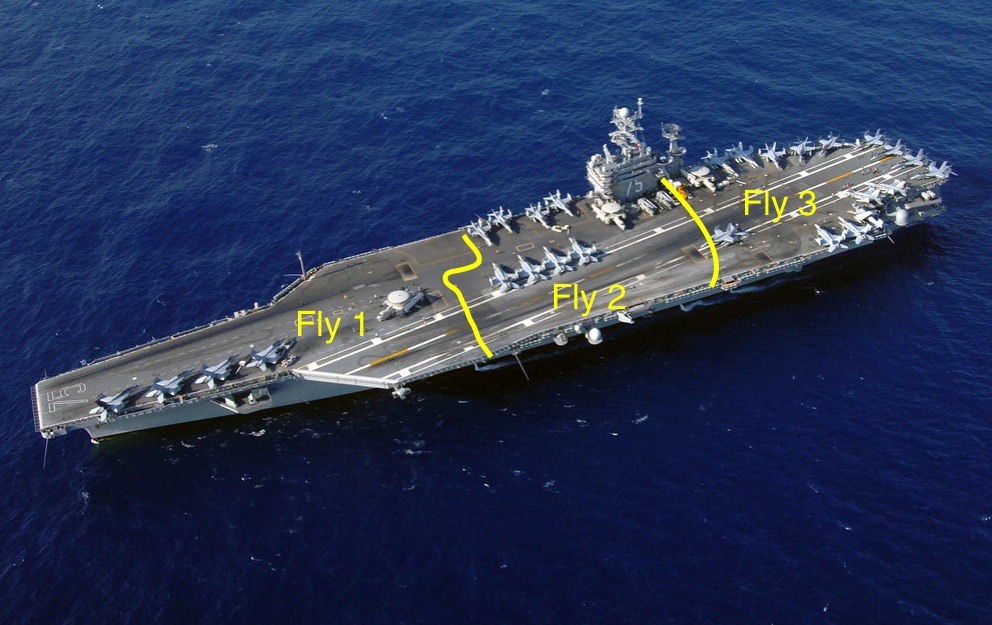‘I thought I was going to be caught in the middle of a flight deck fire that night. It was pretty scary,’ Robbie Emberson, former Flight Deck ABH aboard USS Ronald Reagan.
Modern US Navy aircraft carrier air operations include the operation of fixed-wing and rotary aircraft on and around an aircraft carrier for the performance of combat or noncombat missions.
On an aircraft carrier flight deck, a specialized crew is employed for the different roles utilized in managing air operations. The different flight deck crews wear colored jerseys to visually distinguish their functions:
- Yellow: Aircraft handling officer
- Green: Catapult and arresting gear crew
- Red: Ordnance handler
- Purple: Aviation fuel handler
- Blue: Trainee plane handler
- Brown: Air wing plane captain
- White: Quality Assurance
‘The flight deck is an exciting place to work,’ says Robbie Emberson, former Flight Deck Aviation Boatswain’s Mate (Handling) (ABH) aboard USS Ronald Reagan (CVN-76) on Quora. ‘During flight ops turning propellers can cut you thinner than sliced bread, jet intakes and exhaust can burn you crispier than well-done steak, or one wrong step can send you plunging 134ft down into the frigid water below. But none of these things happened to me.
‘The flight deck is separated into three work centers for V-1 (flight deck ABHs), FLY 1 is responsible for the bow, FLY 2 is responsible for the middle, and FLY 3 is responsible for the fantail.

‘This is a basic sketch of how the FLY’s are separated but there are a number of exceptions. For example, a FLY 3 yellow shirt will stand up in FLY 1 during recovery to “catch” birds when they land. Meaning, he will signal to the pilot to let off the brakes after the wires stop the plane’s forward momentum, when the wire has separated from his aircraft, to raise his tail hook, and direct him out of the landing area.’
Emberson continues:
‘One of the scariest things that happened to me on an aircraft carrier was when I was a U.I. [Under Instruction] yellow shirt in FLY 3. During recovery, FLY 3 sees little action because no aircraft can be sent back there while birds are landing, so most FLY 3 yellow shirts go down in the fly hole and listen to the flight deck radio, have a snack or whatever, and wait. Tonight, however, a friend and I were standing by the arresting gear shooting the s**t enjoying the night.
‘As we were standing there, an F-18 is coming into land. What seemed like 10 feet away from the wires the aircraft’s nose rapidly swings up. The bird had been waved off; something had fouled the landing area and the green light signaling a clear landing area had turned red.

‘This is approximately where we were standing and the bird was probably that close to landing when it had been waved off.
‘The aircraft was nearly perpendicular to the flight deck trying to climb back into the night sky but, unbeknownst to the pilot, the tail hook had caught a wire and he was attached to the deck.
‘So, here we are. My buddy and I standing there in FLY 3 by the arresting gear, an F-18 on full power, roaring, trying to gain altitude, streams of fire coming out of the exhaust, and the thick cables of the arresting gear not letting go, pulling the jet back towards the deck. We did what anyone would do, we ran.
‘I thought the jet was going to explode when it crashed back onto the deck, the blast killing us or sending us flying over the edge of the deck. But, it didn’t. The jet did smash back on the deck causing damage to the aircraft and a lot of sparks, but no fire started. The pilot was bloodied up when he eventually got out of the plane but he walked away. Flight ops continued after a FOD walk-down.’
Emberson concludes:
‘I thought I was going to be caught in the middle of a flight deck fire that night. It was pretty scary.’
Photo by US Navy

